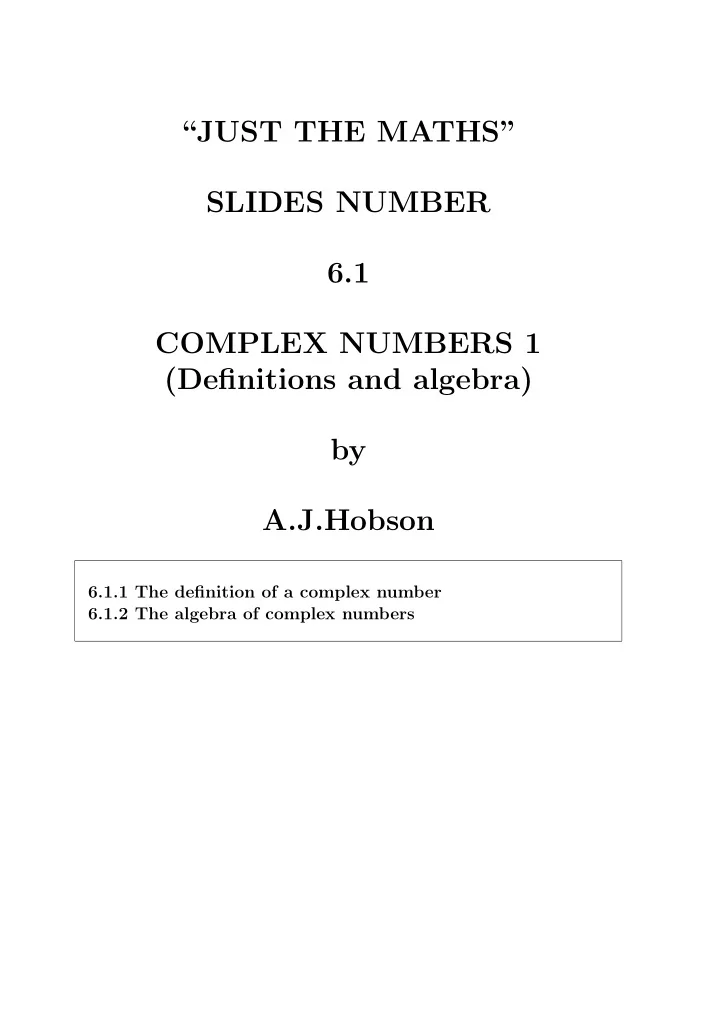

“JUST THE MATHS” SLIDES NUMBER 6.1 COMPLEX NUMBERS 1 (Definitions and algebra) by A.J.Hobson 6.1.1 The definition of a complex number 6.1.2 The algebra of complex numbers
UNIT 6.1 - COMPLEX NUMBERS 1 DEFINITIONS AND ALGEBRA 6.1.1 THE DEFINITION OF A COMPLEX NUMBER INTRODUCTION Equations of the form a d 2 y d x 2 + b d y d x + cy = f ( x ) , are called “Differential Equations”. One method is to solve, first, the quadratic equation with coefficients a , b and c and, hence, solutions √ b 2 − 4 ac − b ± . 2 a ILLUSTRATION Consider d 2 y d x 2 − 6d y d x + 13 = 2 sin x. We solve, first, the quadratic equation with coefficients 1, − 6 and 13. 1
The solutions are 6 ± √ 36 − 52 = 6 ± √− 16 2 2 = 6 ± 4 √− 1 √ = 3 ± 2 − 1 . 2 Notes: (i) The symbol √− 1 will be regarded as an “imaginary” number. (ii) √− 1 will be denoted by j . (iii) Solutions (involving j ) of a quadratic equation, will always be of the form a + bj or a + jb , where a and b are ordinary numbers of elementary arithmetic. DEFINITIONS 1. The term “complex number” denotes any expres- sion of the form a + bj or a + jb where a and b are ordinary numbers of elementary arithmetic (including zero) and j 2 = − 1. 2. If a = 0, then bj or jb is “purely imaginary” . 3. If b = 0 then a + j 0 = a + 0 j = a is “real” . 2
4. For a + bj or a + jb , a is the “real part” and b is the “imaginary part” . 5. a ± bj or a ± jb form a pair of “complex conjugates” . Note: Other convenient notations include z = x + jy and z = x − jy. 6.1.2 THE ALGEBRA OF COMPLEX NUMBERS INTRODUCTION (a) EQUALITY Two complex numbers are defined to be equal if they have the same real part and the same imaginary part. That is, a + jb = c + jd if and only if a = c and b = d. 3
EXAMPLE Determine x and y such that (2 x − 3 y ) + j ( x + 5 y ) = 11 − j 14 . Solution EQUATING REAL AND IMAGINARY PARTS, 2 x − 3 y = 11 , x + 5 y = − 14 . These give x = 1 and y = − 3. (b) ADDITION AND SUBTRACTION We add (or subtract) the real parts and the imaginary parts. That is, ( a + jb ) ± ( c + jd ) = ( a ± c ) + j ( b ± d ) . EXAMPLE ( − 7 + j 2) + (10 − j 5) = 3 − j 3 = 3(1 − j ) and ( − 7 + j 2) − (10 − j 5) = − 17 + j 7. 4
(c) MULTIPLICATION This is defined by ( a + jb )( c + jd ) = ( ac − bd ) + j ( bc + ad ) . EXAMPLES 1. (5+ j 9)(2+ j 6) = (10 − 54)+ j (18+30) = − 44+ j 48 . 2. (3 − j 8)(1 + j 4) = (3 + 32) + j ( − 8 + 12) = 35 + j 4 . 3. ( a + jb )( a − jb ) = a 2 + b 2 . Note: The product of a complex number and its complex con- jugate is always a real number consisting of the sum of the squares of the real and imaginary parts. (d) DIVISION The method is to multiply both the numerator and the denominator of the complex ratio by the conjugate of the denominator, giving a + jb c + jd = a + jb c − jd = ( ac + bd ) + j ( bc − ad ) c + jd.c − jd . c 2 + d 2 5
EXAMPLES 1. 5 + j 3 2 + j 7 = 5 + j 3 2 + j 7 . 2 − j 7 2 − j 7 = (10 + 21) + j (6 − 35) = 31 − j 29 . 2 2 + 7 2 53 Hence, the real part is 31 53 and the imaginary part is − 29 53 . 2. j 2 − 4 = 6 + j 6 + j j 2 − 4 . − j 2 − 4 − j 2 − 4 = ( − 24 + 2) + j ( − 4 − 12) = − 22 − j 16 . ( − 2) 2 + ( − 4) 2 20 Hence the real part is − 22 20 = − 11 10 and the imaginary part is − 16 20 = − 4 5 . 6
Recommend
More recommend